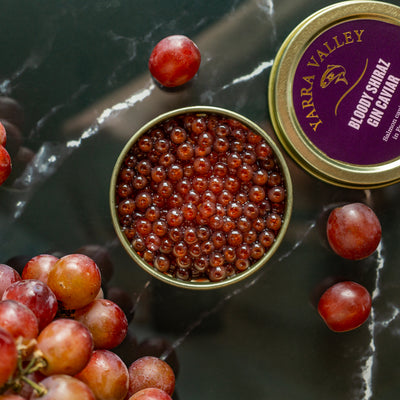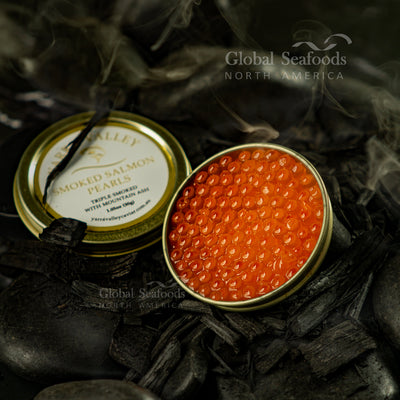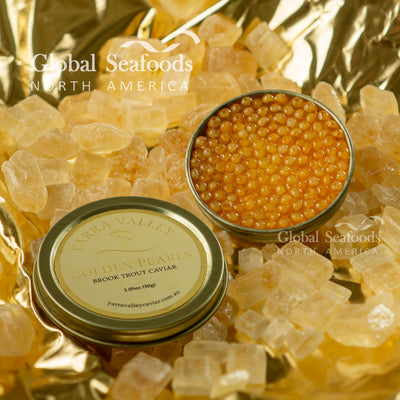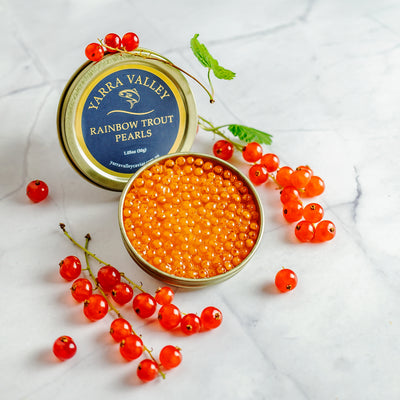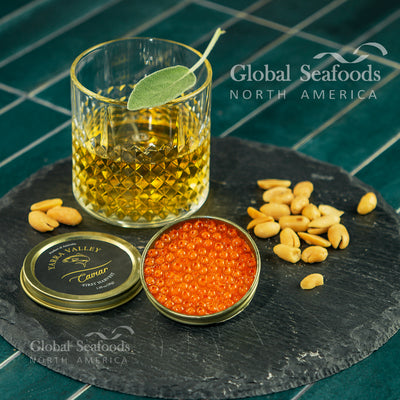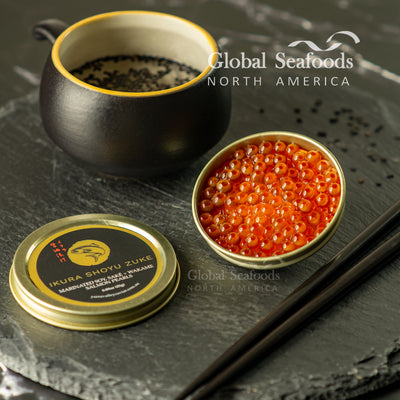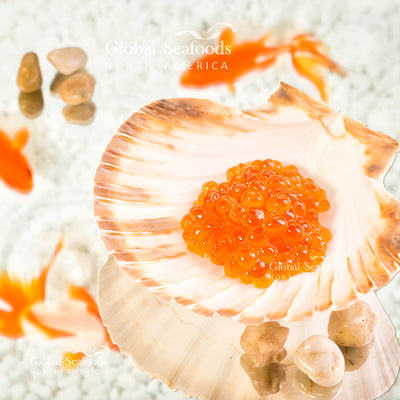Ikura Bibimbap: A Korean Twist on a Japanese Classic

Ikura Bibimbap: Recipe
Fusion cuisine has always been at the forefront of culinary innovation, allowing chefs and home cooks alike to explore new flavors and combinations. One such exciting fusion is Ikura Bibimbap, where the best of Korean and Japanese ingredients come together to create a dish that’s both bold and refined. By combining the iconic Korean rice dish bibimbap with the delicate and briny salmon roe, or Ikura, this recipe takes an adventurous approach that’s sure to impress your taste buds.
Ikura Bibimbap layers the traditional elements of bibimbap, such as mixed vegetables, a fried egg, and spicy gochujang sauce, with the umami-rich burst of salmon roe. This dish offers a dynamic interplay of textures and flavors, transforming a beloved comfort food into a gourmet experience. If you're a fan of both Japanese and Korean cuisine, this fusion dish will give you the best of both worlds.
What Makes Ikura Bibimbap Special?
While traditional bibimbap is already a flavorful and visually stunning dish, the addition of Ikura elevates it to a new level of luxury. Ikura—salmon roe—is known for its large, glossy orange eggs that burst with briny flavor. By topping bibimbap with high-quality Ikura, you enhance the dish with a seafood element that’s rich in umami, offering a beautiful contrast to the earthy vegetables and spicy gochujang.
Bibimbap, meaning “mixed rice” in Korean, traditionally features a base of steamed rice topped with sautéed vegetables, kimchi, a fried egg, and gochujang (Korean chili paste). In the Ikura Bibimbap variation, salmon caviar takes center stage, adding a Japanese twist to the recipe. The fusion of flavors is not only delicious but also visually appealing, making it a perfect dish to impress at any dinner gathering.
Chef and food personality Roy Choi, a pioneer of Korean-Mexican fusion, often highlights the beauty of mixing cultures through food. He once said, “Fusion isn't about making something different. It’s about celebrating what’s already good, from two different perspectives.” That’s exactly what Ikura Bibimbap does—celebrates the best of Japanese and Korean culinary traditions.
Choosing the Best Ikura and Ingredients
The secret to mastering Ikura Bibimbap is using the freshest, highest-quality ingredients, especially when it comes to Ikura. Whether you're sourcing Chum Salmon Caviar or Coho Salmon Caviar, selecting premium-grade salmon roe will make a noticeable difference in both flavor and presentation.
1. Ikura (Salmon Roe)
Salmon roe, known as Ikura, is a delicate and flavorful ingredient that brings a luxurious touch to any dish. The best Ikura has firm, plump eggs with a vibrant orange color and a clean, salty taste. To ensure you're getting the highest quality, purchase from trusted suppliers like Global Seafoods. They offer a variety of premium caviar options, including Pink Salmon Caviar and Trout Red Caviar.
2. Rice
A good bibimbap starts with perfectly cooked short-grain rice. Short-grain rice is sticky and slightly chewy, making it the ideal base to absorb the flavors of the toppings and sauce.
3. Vegetables
Classic bibimbap includes an assortment of sautéed and seasoned vegetables like spinach, carrots, bean sprouts, and zucchini. These vegetables add a lightness to the dish and balance out the richness of the Ikura.
4. Gochujang (Korean Chili Paste)
Gochujang is a fermented Korean chili paste that adds a spicy, slightly sweet kick to the dish. Its deep flavor pairs beautifully with the salty, briny taste of Ikura.
5. Egg
A fried egg is a staple of bibimbap. The runny yolk, when mixed with the rice and vegetables, adds creaminess to the dish and enhances the overall flavor.
6. Optional Additions
To further enhance your Ikura Bibimbap, consider adding Bloody Shiraz Infused Caviar for a striking visual contrast or Golden Pearls Brook Trout Caviar for a different texture and flavor profile.
How to Make Ikura Bibimbap: Step-by-Step Recipe
Now that you have the essential ingredients, let’s walk through the process of making Ikura Bibimbap. This step-by-step guide will help you master the recipe with ease, ensuring your dish is both beautiful and delicious.
Ingredients:
- 2 cups short-grain rice (steamed)
- 1/2 cup Ikura (salmon roe)
- 2 carrots, julienned
- 1 zucchini, thinly sliced
- 1 cup spinach
- 1/2 cup bean sprouts
- 2 tablespoons sesame oil
- 2 eggs (fried)
- 2 tablespoons gochujang (Korean chili paste)
- 1 tablespoon soy sauce
- 1 tablespoon sesame seeds
- Fresh chives or green onions for garnish
Instructions:
-
Cook the Rice
Begin by steaming the short-grain rice according to the package instructions. Once done, set it aside and keep it warm. -
Prepare the Vegetables
Heat a tablespoon of sesame oil in a pan and lightly sauté the vegetables individually. Start with the carrots, followed by the zucchini, spinach, and bean sprouts. Each vegetable should be tender but still crisp. Season with soy sauce and a sprinkle of sesame seeds. -
Fry the Eggs
In a separate pan, fry the eggs until the whites are set, but the yolks remain runny. This will help create a creamy sauce when mixed into the bibimbap. -
Assemble the Bibimbap
Divide the steamed rice into two bowls. Arrange the sautéed vegetables on top of the rice, placing each vegetable in its own section to create a visually appealing dish. -
Add the Ikura
Carefully spoon the Ikura or Coho Salmon Caviar in the center of the bowl, or around the vegetables, depending on your preferred presentation. The Ikura’s vibrant color will provide a beautiful contrast to the rest of the dish. -
Top with Egg and Gochujang
Place a fried egg on top of each bowl and add a dollop of gochujang to taste. Garnish with fresh chives or green onions and a final sprinkle of sesame seeds. -
Serve and Enjoy
Serve the Ikura Bibimbap immediately. To eat, mix all the ingredients together, allowing the flavors to meld into each bite.
Variations on Ikura Bibimbap
Though this recipe is already a fusion of Japanese and Korean cuisine, there are plenty of ways to customize Ikura Bibimbap to your taste preferences.
1. Seafood Bibimbap
For seafood lovers, add grilled shrimp, squid, or scallops to the mix. The seafood will enhance the oceanic flavors of the Ikura, making the dish even more luxurious. Consider using Rainbow Trout Pearls for a lighter roe option that pairs well with delicate seafood.
2. Vegetarian Ikura Bibimbap
For a vegetarian version, simply omit the egg and add more vegetables, such as shiitake mushrooms or sautéed tofu. Top with Pink Salmon Caviar for a plant-forward twist that doesn’t compromise on flavor.
3. Spicy Tuna Ikura Bibimbap
If you enjoy a spicier kick, add diced tuna mixed with a bit of sriracha or spicy mayo. The creamy, spicy tuna will complement the Ikura beautifully and add more depth to the dish.
Why Choose Premium Ikura for This Dish?
The quality of the Ikura used in this dish is critical to achieving the best flavor and texture. Premium Ikura, such as Chum Salmon Caviar or Coho Salmon Caviar, offers a firm texture and a clean, briny taste that complements the other flavors of bibimbap without overpowering them.
As world-renowned chef Jacques Pépin said, “A recipe is only as good as its ingredients.” When it comes to Ikura Bibimbap, this couldn’t be more true. The fresh, high-quality Ikura from Global Seafoods ensures that every bite is bursting with flavor, offering a superior culinary experience.
Frequently Asked Questions About Ikura Bibimbap
What is Ikura?
Ikura is salmon roe, known for its large, orange eggs and briny flavor. It is commonly used in Japanese cuisine but works wonderfully in fusion dishes like Ikura Bibimbap.
Can I make Ikura Bibimbap in advance?
You can prepare the vegetables and rice in advance, but it's best to add the Ikura and fried egg just before serving to maintain their freshness and texture.
Where can I buy the best Ikura for this dish?
You can find premium Ikura from Global Seafoods, where a variety of high-quality salmon caviar options are available.
How should Ikura be stored?
Ikura should be stored in the refrigerator and consumed within a few days of opening. For longer storage, you can freeze it, but thaw slowly in the refrigerator to maintain its texture and flavor.
What other dishes can I make with Ikura?
Ikura is incredibly versatile and can be used in sushi, rice bowls, pasta, or even as a garnish for scrambled eggs. Try experimenting with Trout Red Caviar or Golden Pearls Brook Trout Caviar for different flavor profiles.
Also in Recipes

How to Cook Live Manila Clams at Home: Fresh, Sweet & Delivered Overnight
Discover how to store, clean, and cook Live Manila Clams at home using simple chef techniques. Learn why these Pacific clams are perfect for pasta vongole, steaming, chowders, and more—plus how to order them fresh in a convenient 10 lb bag shipped overnight.

Boiled Crab for Brunch: The Ultimate Guide to Morning Seafood
Discover the joy of Boiled crab for brunch! Learn how to prepare seafood in the morning, its health benefits, and recipes to make your brunch memorable.



